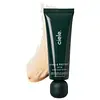What's inside
What's inside
 Key Ingredients
Key Ingredients

No key ingredients
 Benefits
Benefits

 Ingredients Side-by-side
Ingredients Side-by-side

Zinc Oxide 10%
Cosmetic ColorantWater
Skin ConditioningCaprylic/Capric Triglyceride
MaskingButylene Glycol
HumectantPolyhydroxystearic Acid
EmulsifyingHydroxyethyl Acrylate/Sodium Acryloyldimethyl Taurate Copolymer
Emulsion StabilisingTocopheryl Acetate
AntioxidantXylitol
HumectantXylitylglucoside
HumectantAnhydroxylitol
HumectantSodium Olivate
CleansingNeopentyl Glycol Diethylhexanoate
EmollientDimethicone
EmollientTriethoxycaprylylsilane
Citric Acid
BufferingPhenoxyethanol
PreservativeEthylhexylglycerin
Skin ConditioningIron Oxides
Zinc Oxide 10%, Water, Caprylic/Capric Triglyceride, Butylene Glycol, Polyhydroxystearic Acid, Hydroxyethyl Acrylate/Sodium Acryloyldimethyl Taurate Copolymer, Tocopheryl Acetate, Xylitol, Xylitylglucoside, Anhydroxylitol, Sodium Olivate, Neopentyl Glycol Diethylhexanoate, Dimethicone, Triethoxycaprylylsilane, Citric Acid, Phenoxyethanol, Ethylhexylglycerin, Iron Oxides
 Reviews
Reviews

Ingredients Explained
These ingredients are found in both products.
Ingredients higher up in an ingredient list are typically present in a larger amount.
Butylene Glycol (or BG) is used within cosmetic products for a few different reasons:
Overall, Butylene Glycol is a safe and well-rounded ingredient that works well with other ingredients.
Though this ingredient works well with most skin types, some people with sensitive skin may experience a reaction such as allergic rashes, closed comedones, or itchiness.
Learn more about Butylene GlycolWater. It's the most common cosmetic ingredient of all. You'll usually see it at the top of ingredient lists, meaning that it makes up the largest part of the product.
So why is it so popular? Water most often acts as a solvent - this means that it helps dissolve other ingredients into the formulation.
You'll also recognize water as that liquid we all need to stay alive. If you see this, drink a glass of water. Stay hydrated!
Learn more about Water